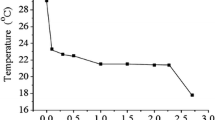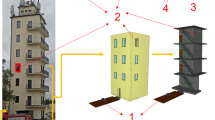Abstract
Investigations of ventilation in an immersed tunnel have recently drawn greater research attentions; however, analyses on the influence of vent design and tunnel width on ventilation performance have rarely been addressed. For the sake of the security of evacuees in an immersed tunnel fire, the influence of three vent designs and two immersed tunnel widths on mechanical ventilation performance during tunnel fires were numerically investigated using large eddy simulation. The pollutant gas flow characteristics in the tunnel after a fire were analyzed, and the pollutant gas exhaust efficiency based on the mass conservation of carbon monoxide in the smoke was proposed in this study. By comparing the smoke propagation, smoke distribution, and exhaust efficiency between three different vent designs, it was determined that the Top Vent Design has the best smoke exhaust effect, and the Sidewall Vent Design (with an activated vertical smoke screen) has a better smoke exhaust effect than the Sidewall Vent Design. The influences of the tunnel width and heat release rate of the fire on the ventilation effect were also investigated.
















Similar content being viewed by others
Data availability
The datasets used or analyzed during the current study are available from the corresponding author on reasonable request.
References
Ali H, Davood K (2019) Estimation of real-world traffic emissions for CO, SO2, and NO2 through measurements in urban tunnels in Tehran, Iran. Environ Sci Pollut Res 26:26577–26592
Babrauskas V, Gann RG, Levin BC, Paabo M, Harris RH, Peacock RD, Yusa S (1998) A methodology for obtaining and using toxic potency data for fire hazard analysis. Fire Saf J 31(4):345–358
Carvel RO, Beard AN, Jowitt PW, Drysdale DD (2004) The influence of tunnel geometry and ventilation on the heat release rate of a fire. Fire Technol 40(1):5–26
Chang HC, Kim TK, Son BS, Park WH (2008) Study on heat and smoke exhaust characteristics for different operating modes of platform and tunnel fans during a passenger train fire. Fire Science and Engineering 22(1):61–67
Delichatsios MA (1981) The flow of fire gases under a beamed ceiling. Combustion and Flame 43:1–10
Fan C, Chen J, Zhou Y, Li L, Zhang J, Fan M, Liu X (2021) A simple method to improve smoke exhaust effectiveness of a shallow-buried urban tunnel fire with natural ventilation. Combust Sci Technol 193(3):355–378
Fu Q, Peng B, Chen L (2014) Performance-based smoke prevention and extraction system design for an exhibition center. Procedia Engineering 71:544–551
Gannouni S, Ben Maad R (2016) Numerical analysis of smoke dispersion against the wind in a tunnel fire. J Wind Eng Ind Aerodyn 158:61–68
Gao Z, Wan H, Ji J (2020) The effect of blend ratio on the combustion process of mutually stratified blended fuels pool fire. Proc Combust Inst
Heskestad G, Delichatsios M A (1979) The initial convective flow in fire 17(1), 1113-1123.
Ingason H, Lönnermark A (2010, March) Effects of longitudinal ventilation on fire growth and maximum heat release rate. In Proceedings from the Fourth International Symposium on Tunnel Safety and Security, Germany (pp. 395-406).
Ji J, Gao ZH, Fan CG, Sun JH (2013) Large eddy simulation of stack effect on natural smoke exhausting effect in urban road tunnel fires. Int J Heat Mass Transf 66:531–542
Kim E, Woycheese JP, Dembsey NA (2008) Fire dynamics simulator (version 4.0) simulation for tunnel fire scenarios with forced, transient, longitudinal ventilation flows. Fire Technol 44(2):137–166
Lee EJ, Oh CB, Oh KC, Yoo YH, Shin HJ (2010) Performance of the smoke extraction system for fires in the busan–geoje immersed tunnel. Tunneling and Underground Space Technology 25(5):600–606
Li Y, Ingason H (2011) The fire growth rate in a ventilated tunnel fire. Fire Safety Science 10(10):347–258
Liu Y, Yang D, Xiao Y, Mao S, Yang M (2018) Combining diverse driving forces for smoke control in complex urban traffic link tunnels (UTLTs) using one-dimensional flow modelling. Sustain Cities Soc 43:265–274
Mao SH, Yang D (2016) One-dimensional analysis for optimizing smoke venting in tunnels by combining roof vents and longitudinal ventilation. Appl Therm Eng 108:1288–1297
McGrattan, K., Hostikka, S., Floyd, J., Baum, H., Rehm, R., Mell, W., McDermott, R., 2015. Fire dynamics simulator (version 6), technical reference guide. NIST Special Publication (6).
McGrattan, K., Hostikka, S., McDermott, R., Floyd, J., Weinschenk, C., Overholt, K., 2016. Fire dynamics simulator, user’s guide (version 6). NIST Special Publication, 20.
Meng N, Hu L, Wu L, Yang L, Zhu S, Chen L, Tang W (2014) Numerical study on the optimization of smoke ventilation mode at the conjunction area between tunnel track and platform in emergency of a train fire at subway station. Tunneling and Underground Space Technology 40:151–159
Meroney RN, Hill DW, Derickson R, Stroup J, Weber K, Garrett P (2015) CFD simulation of ventilation and smoke movement in a large military firing range. J Wind Eng Ind Aerodyn 136:12–22
Mohammad NY, Mohammad A, Maryam D (2019) Developing air exchange rate models by evaluating vehicle in-cabin air pollutant exposures in a highway and tunnel setting: case study of Tehran, Iran. Environ Sci Pollut Res 26:501–513
NFPA92B (2009) Guide for smoke management systems in malls, atria, and large areas.
Tan GL (2002) Fire fighting in tunnels. Tunneling and Underground Space Technology Incorporating Trenchless Technology Research 17(2):179–180
Tanaka T, Fujita T, Yamaguchi J (2000) Investigation into rise time of buoyant fire plume fronts. International Journal on Engineering Performance-Based Fire Codes 2(1):14–25
Tang F, He Q, Shi Q (2017) Experimental study on thermal smoke layer thickness with various upstream blockage–fire distances in a longitudinal ventilated tunnel. J Wind Eng Ind Aerodyn 170:141–148
Wan H, Gao Z, Han J, Ji J, Ye M, Zhang Y (2019a) A numerical study on smoke back-layering length and inlet air velocity of fires in an inclined tunnel under natural ventilation with a vertical shaft. Int J Therm Sci 138:293–303
Wan H, Gao Z, Ji J, Wang L, Zhang Y (2019b) Experimental study on merging behaviors of two identical buoyant diffusion flames under an unconfined ceiling with varying heights. Proc Combust Inst 37(3):3899–3907
Xu P, Xing RJ, Jiang SP, Li LJ (2019) Theoretical prediction model and full-scale experimental study of central smoke extraction with a uniform smoke rate in a tunnel fire. Tunneling and Underground Space Technology 86:63–74
Yang D, Huo R, Zhang XL, Zhao XY (2011) Comparison of the distribution of carbon monoxide concentration and temperature rise in channel fires: reduced-scale experiments. Appl Therm Eng 31:528–536
Yang D, Ding Y, Du T, Mao SH, Zhang ZJ (2018) Buoyant back-layering and the critical condition for preventing back-layering fluid in inclined tunnels under natural ventilation: brine water experiments. Exp Thermal Fluid Sci 90:319–329
Zhang XC, Zhang ZJ, Su GK, Tao HW, Xu WH, Hu LH (2019) Buoyant wind-driven pollutant dispersion and recirculation behaviour in wedge-shaped roof urban street canyons. Environ Sci Pollut Res 26:8289–8302
Zhao D, Jiang J, Zhou R, Tong Y, Wu F, Shi L (2016) Numerical study on the optimization of smoke ventilation mode for interchange subway station fire. Int J Vent 15(1):79–93
Zhao W, Ouyang R, Ran Q, Chen T, Xu Z, Zou M, Fan C (2021) An experimental study on smoke back-layering and critical velocity in tunnel fires with canyon cross wind. J Wind Eng Ind Aerodyn 209:104477
Zhou T, Wang XH, He JJ, Chen QP, Wang J (2019a) The effect of forced ventilation by using two movable fans on thermal smoke movement in a tunnel fire. J Wind Eng Ind Aerodyn 184:321–328
Zhou Y, Yang Y, Mao Z, Bu R, Gong J, Wang Y, Yi L (2019b) Analytical and numerical study on natural ventilation performance in single-and gable-slope city tunnels. Sustain Cities Soc 45:258–270
Funding
This study was supported by the National Natural Science Foundation of China (Grant No. 51974361 and 52008068), Natural Science Foundation of Hunan Province of China (No. 2020JJ3046), the Fundamental Research Funds for the Central Universities of Central South University (Grant Nos. 502501004 and 502045009), Emei to Hanyuan Expressway Engineering Research Project (Grant No. LH-HT-45), and General Fund of Chongqing Natural Science Foundation (Grant No. cstc2020jcyj-msxm3094 and cstc2019jcyj-msxmX0600).
Author information
Authors and Affiliations
Contributions
Conceptualization: L. J. Li and C. G. Fan; methodology: Q. Z. Qiu, P. Xu and X.F. Zhang; formal analysis and investigation: Q. Z. Qiu, and Y. L. Li; writing—original draft preparation: J. L. Liu; writing—review and editing: Y. L. Li, J. L. Liu; resources and supervision: C. G. Fan
Corresponding author
Ethics declarations
Ethics approval and consent to participate
Not applicable.
Consent for publication
Not applicable.
Competing interests
The authors declare no competing interests.
Additional information
Responsible Editor: Philippe Garrigues
Publisher’s note
Springer Nature remains neutral with regard to jurisdictional claims in published maps and institutional affiliations.
Rights and permissions
About this article
Cite this article
Li, L., Qiu, Q., Zhang, X. et al. Assessment of different ventilation strategies on ventilation performance in immersed tunnels. Environ Sci Pollut Res 28, 31838–31849 (2021). https://doi.org/10.1007/s11356-021-12818-9
Received:
Accepted:
Published:
Issue Date:
DOI: https://doi.org/10.1007/s11356-021-12818-9




